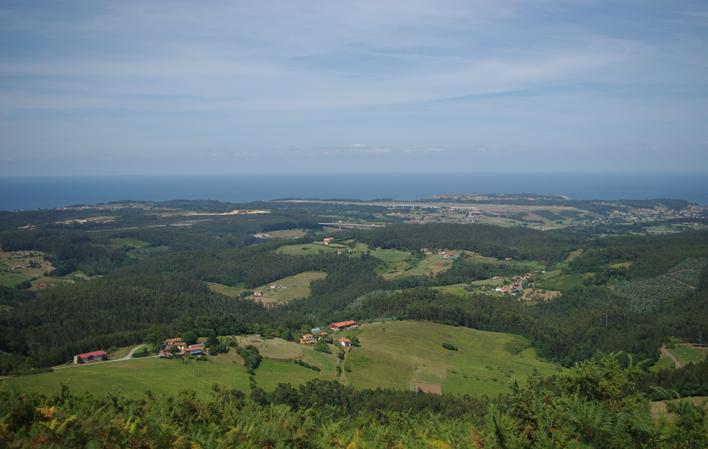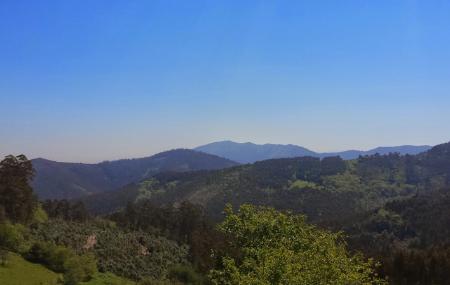
Tricking the Pulide, Arbedales Cave
- Address Avilés and Castrillón Asturias Centre
- Distance Distance: 37,4 kms
- Difficulty Difficulty: Half
- Altitude Altitude: 368.32 (maximum)
- Mountain bike Mountain bike: 1 day
- Start point Start point: Avilés
- Route type Route type: mtb
- Tour type Tour type: Circular
- Layout of the route Layout of the route: Download kml
Route
Avilés - Avilés 37,38
This circular route is suitable for all types of bicycles and after a long climb of 7 km it practically reaches a high point with a certain fame among the most demanding cyclists in the region of Avilés: the Alto de Pulide (362 m).
This is a circular cycling tour, starting and finishing at the same point. It runs entirely on tarmac and is therefore suitable for all types of bicycles. The only thing to mention is a long climb of 7 km that can be done easily by pedalling.
It is a curious route, as you are going to climb and, almost almost, to reach a high point with a certain fame among the most demanding cyclists in the region of Avilés: the Alto de Pulide (362 m).
Don't panic, the climb is quite gentle and comfortable, and the only way down is the hard part, near Pillarno, to reach the grotto or cave of Los Arbedales, which you can visit.
The route runs along sections that are not very well explored. The start is from the FEVE halt in Avilés and you will have to cycle along the flat area of the Avilés industrial estates, which leaves the Avilés estuary on the right, until you reach the cycle path that leads to Salinas. From there the pedalling will continue along another comfortable cycle path to Piedras Blancas, the capital of Castrillón, where we recommend a light snack if we are in good time.
Once out of Piedras Blancas and the FEVE tracks have been crossed, the route runs along a very quiet local road which, in a reasonable climb, will approach the Pulide pass, but without having to climb up to it, because as soon as you see that the road is cut by another road, it descends sharply to the left, dropping you (on the right would be the climb to the Pulide pass, which is not where we are going). The climb is 7 km from Piedras Blancas, but most of it can be done on foot without major problems, and only a few sections may have to be done on foot. The Alto de Pulide is part of the Pulide mountain range, being the highest point of the Castrillón council and the junction with the councils of Illas and Soto del Barco.
From there you can enjoy a fantastic and beautiful descent, which comfortably leads to the second point of interest on the route: the Arbedales cave (www.arbedales.com) in Pillarno.
The privately owned Arbedales Cave was discovered in December 1963 by Manuel del Busto. It is an impressive natural geological formation of stalactites and stalagmites with whimsical shapes, which, according to some, may have inspired the modernist architect Antoni Gaudí. This Devonian cave is 600 metres long and has a constant internal temperature of 14 degrees Celsius.
For those who take this route and want to visit the cave, the visit is guided and commented. Remember to bring a warm jacket, as all caves and grottoes are cold by definition.
For those who bring a snack, there is a recreational area near the cave or, if you prefer, you can go to a restaurant further along the route, for example in the village of Las Bárzanas.
After this stop, continue on a pleasant walk that takes you back to Piedras Blancas. From here, and via a completely different route to the one on the way out, we reach Salinas, where we start to retrace our steps, passing through the port of Avilés, until we reach our final destination, the town of Avilés. And if you wish, before returning, you can visit the Niemeyer Centre, a cultural complex designed by the architect Óscar Niemeyer (the only work of this architect in Spain) and located in the surroundings of the Avilés estuary, contrasting with the old part of the city and the traditional industrial image of the area. Due to its predominant white colour and its size, it is visible from different points and from the air.
Map
Itinerary
Avilés - Salinas - Pillarno - Grutas de Arbedales - Monte Pulide - Piedras Blancas - Avilés




